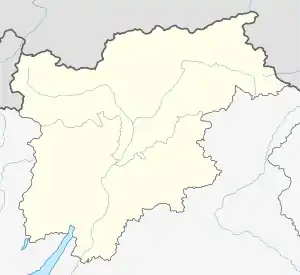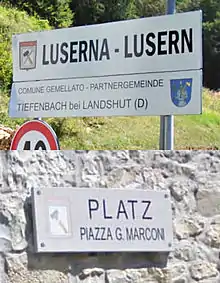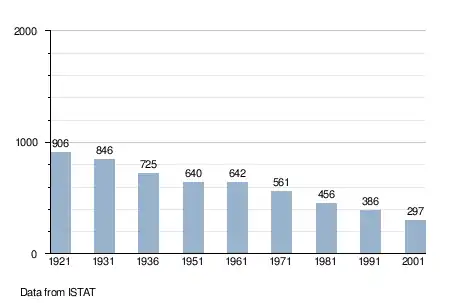Luserna
Lusérn | |
|---|---|
| Kamou vo Lusérn Gemeinde von Lusern Comune di Luserna | |
 Square in Lusérn | |
-Stemma.png.webp) Coat of arms | |
Location of Luserna | |
 Luserna Location of Luserna in Italy  Luserna Luserna (Trentino-Alto Adige/Südtirol) | |
| Coordinates: 45°55′N 11°19′E / 45.917°N 11.317°E | |
| Country | Italy |
| Region | Trentino-Alto Adige/Südtirol |
| Province | Trentino (TN) |
| Government | |
| • Mayor | Gianni Nicolussi Zaiga |
| Area | |
| • Total | 8.2 km2 (3.2 sq mi) |
| Elevation | 1,333 m (4,373 ft) |
| Population (31 December 2021)[2] | |
| • Total | 271 |
| • Density | 33/km2 (86/sq mi) |
| Time zone | UTC+1 (CET) |
| • Summer (DST) | UTC+2 (CEST) |
| Postal code | 38040 |
| Dialing code | 0464 |
| Website | Official website |
Luserna (Cimbrian: Lusérn, German: Lusern) is a comune (municipality) in Trentino in the northern Italian region Trentino-Alto Adige/Südtirol, located about 25 kilometres (16 mi) southeast of Trento. As 2021, it had a population of 271 and an area of 8.2 square kilometres (3.2 sq mi).[3]
Luserna is part of the Magnificent Community of the Cimbrian Highlands (Altipiani Cimbri) together with the municipalities of Lavarone and Folgaria. In the tourist sphere it is part of the Alpe Cimbra. It is one of I Borghi più belli d'Italia ("The most beautiful villages of Italy").[4]
Lusérn borders the following municipalities: Caldonazzo, Lavarone, Levico Terme, Pedemonte, Rotzo and Valdastico.
Cimbrian culture and language


Lusérn is the centre of Cimbrian language and culture. In the 2021 census, around 68,8% of the people of Lusérn stated Cimbrian, an Upper German dialect of the Germanic language, to be their first language.[5]
The Cimbrian spoken in Lusérn is a slightly different dialect from Cimbrian spoken elsewhere.[6]
| Cimbrian | German | English |
|---|---|---|
|
Vatar ünsar |
Vater unser |
Our Father |
Point of interest
The village of Luserna has eight restaurants and hotels, four museums and four thematic trails that tell Cimbrian legends and stories. They are passable by families and mountain bikes, and in winter they become paths suitable for snowshoeing.[8]
Story
Luserna was founded around the year 1400 from Bavarians populations coming from nearby Lavarone who decided to stay and live here. In 1710 Luserna became independent from Lavarone. Until 1918 it was included in the Austro-Hungarian Empire, precisely in the County of Tyrol. During the last years of the 1800s it became famous for its tradition of bobbin lace and thanks to the Austrian administration, it had both German and Italian schools.
After the annexation to the Kingdom of Italy and with the advent of fascism, the people of Luserna were forbidden to speak Cimbro. This is because one of the dogmas of fascism was to Italianize every village and culture. This caused the phenomenon of the Options, an agreement between the Third Reich and the Kingdom of Italy to distribute the Mochen, Cimbrian and German populations who had lived for millennia in the ancient county of Tyrol, which later became the region of Venice Tridentine.
After the Second World War, thanks to the Gruber–De Gasperi Agreement, the Cimbrian linguistic minority of Luserna became part of the autonomy basis of the Autonomous Province of Trento and the Trentino - South Tyrol Region. In 1987 the Mocheno Cimbro Institute was founded and in 2001 the Cimbrian language was officially recognized within the regulations for the protection of Trentino linguistic minorities. In 2008 the regulations were implemented, including the compulsory teaching of the language in schools and the use of the Cimbrian language in public administration documents.
Demographic evolution

Notes and references
- ↑ "Superficie di Comuni Province e Regioni italiane al 9 ottobre 2011". Italian National Institute of Statistics. Retrieved 16 March 2019.
- ↑ "Popolazione Residente al 1° Gennaio 2018". Italian National Institute of Statistics. Retrieved 16 March 2019.
- ↑ All demographics and other statistics: Italian statistical institute Istat.
- ↑ "Trentino Alto Adige" (in Italian). Retrieved 31 July 2023.
- ↑ "RILEVAZIONE SULLA CONSISTENZA E LA DISLOCAZIONE TERRITORIALE DEGLI APPARTENENTI ALLE POPOLAZIONI DI LINGUA LADINA, MÒCHENA E CIMBRA Anno 2021" (PDF). statistica.provincia.tn.it. Retrieved 2023-06-26.
- ↑ "Vaterunser (Luserner Zimbrisch)". (in Lusérn Cimbrian). Kulturinstitut Lusern. 2006. Retrieved 2011-05-13.
- ↑ "Das Vaterunser auf Lusérner Zimbrisch". (in Cimbrian). Frankfurter Allgemeine Zeitung. 2006. Retrieved 2011-05-13.
- ↑ "Alpe Cimbra: Official website of the APT Folgaria, Lavarone, Lusérn, Vigolana".
External links
